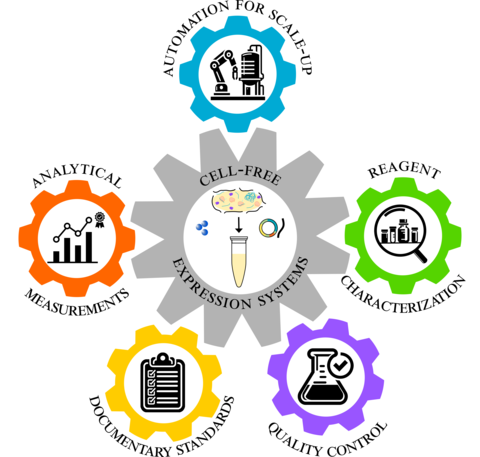Summary
The Cellular Engineering Group works to provide metrology for rapid, successful translation of safe, effective bioproducts based on cell-free expression systems.
Description

Cell-free expression at NIST
Cell-free expression systems are poised to advance the US bioeconomy and play a key role in ensuring US manufacturing resilience. NIST has several, on-going projects in its growing portfolio to promote reproducibility, new measurement methods, and best practices and standards in cell-free expression systems. First, to support biomanufacturing and automation, the Cellular Engineering Group is enabling more reproducible and high-throughput cell-free expression systems through automation methods and quantitative assays for reagent quality and reaction performance. Previous efforts explored sources of variability in DNA template preparation for more reproducible and comparable cell-free protein production. This study leveraged automation to explore potential sources of uncertainty, as well as reduce human error. Second, to speed innovation in synthetic and engineering biology workflows, the Group is investing in cell-free expression systems as a platform for rapid prototyping and optimization of engineered biological parts, towards more sophisticated functions through parts integration. Third, to support design and scale-up, the Group is providing high-quality data, from manual and automated experiments, for modeling, abstraction, and control, as well as best practices for integrating multiple functions for increasingly sophisticated engineered systems and synthetic cells. Fourth, to advance engineering biology through the integration of synthetic biology and nanotechnology, the Group is leveraging encapsulation, coacervation, and chip-based formats towards new engineering capabilities. A chip-based format also facilitates single molecule measurements of dynamic cell-free reactions to inform modeling towards predictive function and design.
RELATED PUBLICATIONS
Eugenia Romantseva, Nina Alperovich, David Ross, Steven P Lund, Elizabeth A Strychalski, Effects of DNA template preparation on variability in cell-free protein production, Synthetic Biology, Volume 7, Issue 1, 2022, ysac015, https://doi.org/10.1093/synbio/ysac015
Garenne, D., Haines, M.C., Romantseva, E.F., Freemont P., Strychalski E.A., Noireaux V. Cell-free gene expression. Nat Rev Methods Primers 1, 49 (2021). https://doi.org/10.1038/s43586-021-00046-x
Romantseva J, Ross D, Alperovich A, Strychalski E, Automated DNA template preparation and quantitation methods, https://www.protocols.io, March 23, 2022, https://dx.doi.org/10.17504/protocols.io.j8nlkk8rdl5r/v1
Romantseva E.F., Tack D.S., Alperovich N., Ross D., Strychalski E.A. (2022) Best Practices for DNA Template Preparation Toward Improved Reproducibility in Cell-Free Protein Production. In: Karim A.S., Jewett M.C. (eds) Cell-Free Gene Expression. Methods in Molecular Biology, vol 2433. Humana, New York, NY. https://doi.org/10.1007/978-1-0716-1998-8_1
“CELL-FREE (Comparable Living Lysates For Research, Education, and Entrepreneurship) workshop Report” E. Romantseva, E. A. Strychalski, https://nvlpubs.nist.gov/nistpubs/SpecialPublications/NIST.SP.1500-13.pdf

